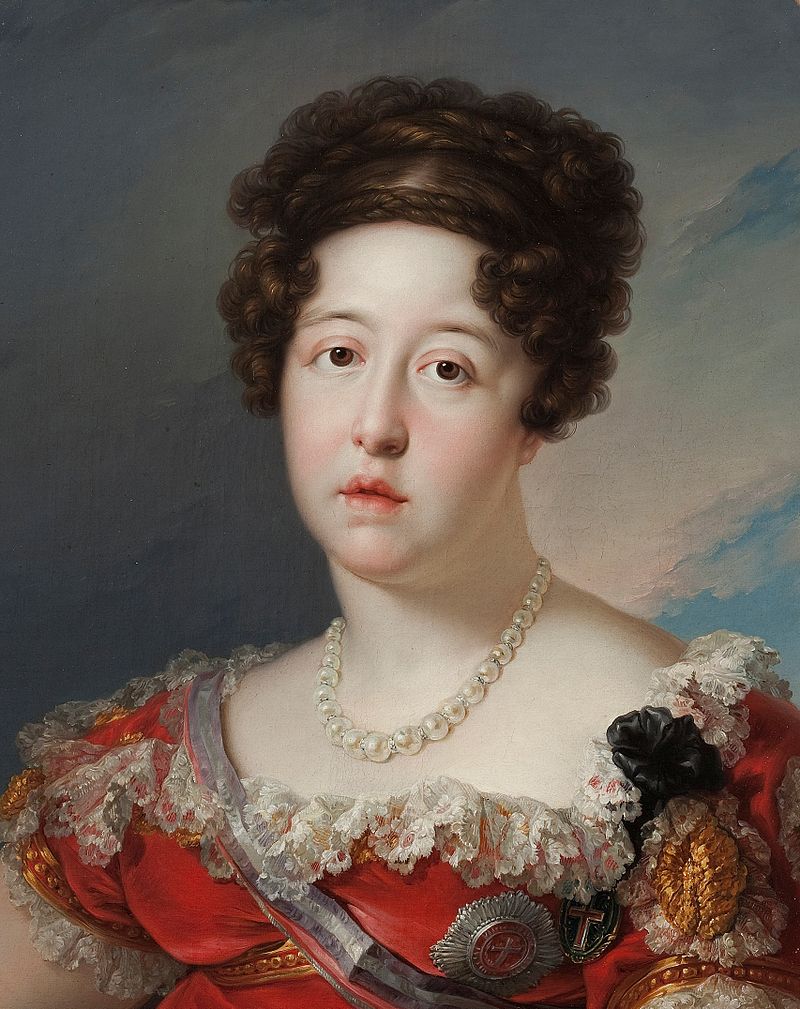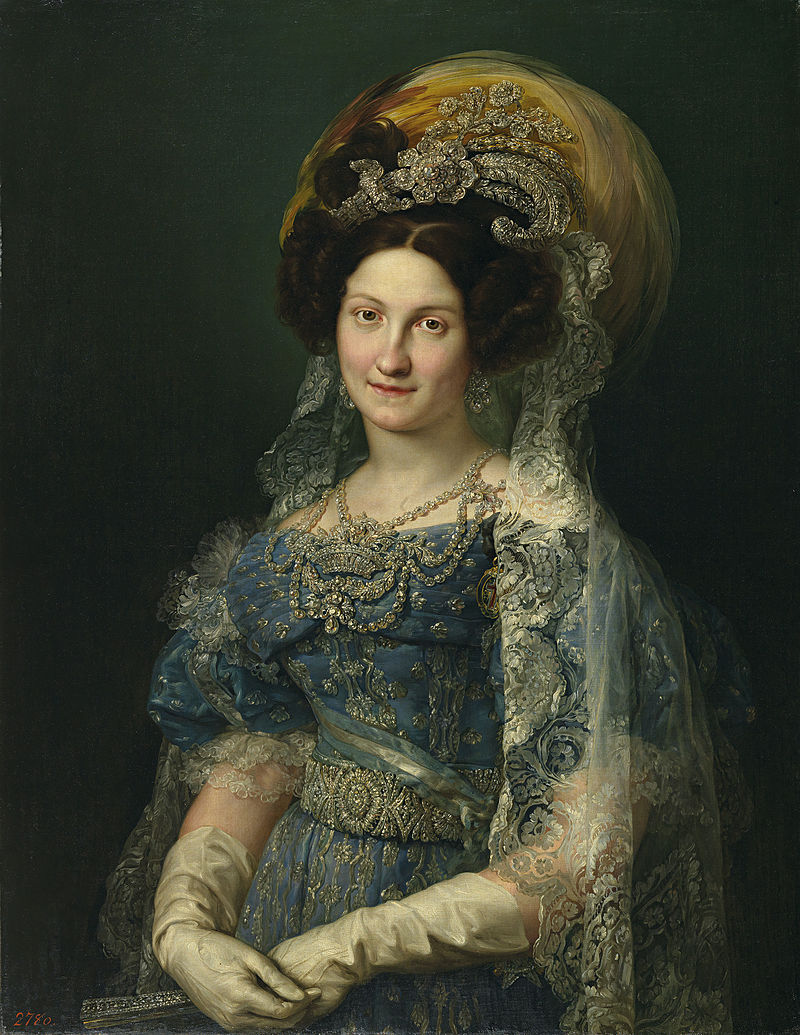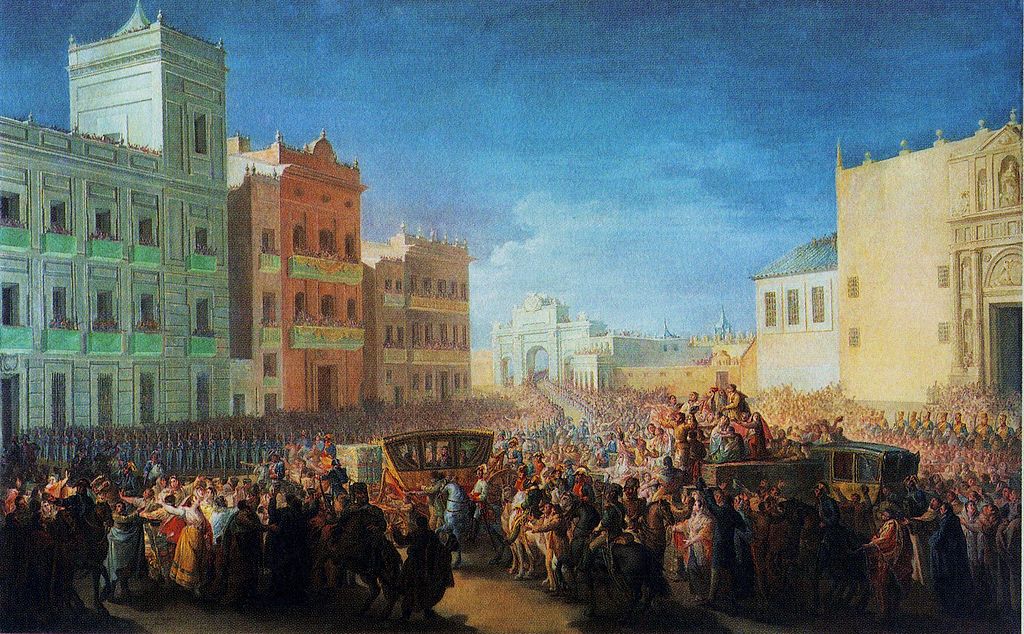by Susan Flantzer © Unofficial Royalty 2015

Credit – Wikipedia
The fourth wife of King Ferdinand VII of Spain and the wife who finally gave him an heir, Maria Christina of the Two Sicilies (Italian: Maria Cristina Ferdinanda) was born in Palermo, Kingdom of Sicily, now in Italy, on April 27, 1806. She was the second of the twelve children of King Francesco I of the Two Sicilies and his second wife Infanta María Isabella of Spain, sister of King Ferdinand VII of Spain.
Maria Christina had two half-siblings from her father’s first marriage to Maria Clementina of Austria:
- Carolina (1798–1870), married (1) Charles Ferdinand d’Artois, Duke of Berry, son of King Charles X of France, had issue (2) Ettore Count Lucchesi Palli, Prince di Campofranco, Duke della Grazia, had issue
- Ferdinando (1800–1801), died young
Maria Christina had five sisters and six brothers:
- Luisa Carlotta (1804–1844), married her maternal uncle Infante Francisco de Paula of Spain, had issue
- Ferdinando II, King of the Two Sicilies (1810–1859), married (1) Maria Cristina of Savoy, had one son (2) Maria Theresa of Austria, had issue
- Carlo, Prince of Capua (1811–1862), married morganatically Penelope Smyth, had issue
- Leopoldo, Count of Syracuse (1813–1860), married Princess Maria of Savoy-Carignan, no surviving issue
- Maria Antonia (1814–1898), married Leopoldo II, Grand Duke of Tuscany, had issue
- Antonio, Count of Lecce (1816–1843)
- Maria Amalia (1818–1857), married Infante Sebastian of Portugal and Spain, no issue
- Maria Carolina (1820–1861), married Infante Carlos of Spain, Count of Montemolin, Carlist pretender to the throne of Spain, no issue
- Teresa (1822–1889), who married Pedro II, Emperor of Brazil, had issue
- Luigi, Count of Aquila (1824–1897), married Januária, Princess Imperial of Brazil, had issue
- Francesco, Count of Trapani (1827–1892), married Archduchess Maria Isabella of Austria, had issue

Family of Francesco I of the Two Sicilies, 1819; Credit – Wikipedia
Irish novelist and journalist Marguerite Gardiner, Countess of Blessington, who met Maria Christina on her Grand Tour of Europe, described her as having flawless facial features, beautiful teeth, expressive eyes, and a charming smile. Maria Christina was lively and cheerful, showed an early fondness for hunting, and a talent for painting. In 1829, the thrice-widowed King Ferdinand VII of Spain was asked by the government to marry again to provide an heir to the throne. Luisa Carlotta of the Two Sicilies, Maria Christina’s elder sister, was married to her maternal uncle and Ferdinand’s brother Infante Francisco de Paula of Spain, and she suggested Maria Christina as a marriage candidate. It did not take long for the 45-year-old Spanish king, who was Maria Christina’s maternal uncle, to decide that Luisa Carlota’s 23-year-old sister was an ideal choice. The court of the Kingdom of the Two Sicilies agreed and Maria Christina traveled to Madrid. On December 11, 1829, the wedding took place at the Royal Basilica of Our Lady of Atocha in Madrid, Spain, and the celebrations continued until the new year.

Ferdinand and Maria Christina, 1831; Credit – Wikipedia
Ferdinand was delighted with his young wife, who soon had a great influence on him. Until his marriage to Maria Christina, he had fathered no surviving child. While the moderate and liberal parties now pinned their hopes on an heir from the new queen, the absolutists (Carlists) favored Ferdinand’s younger brother, Infante Carlos, Count of Molina as the heir apparent. Maria Francisca of Portugal, first wife of Infante Carlos, and her sister, Maria Teresa, Princess of Beira, second wife of Infante Carlos, competed with Maria Christina and her sister Luisa Carlota for influence at the Spanish court. Soon after her marriage, Maria Christina became pregnant. On March 29, 1830, Ferdinand VII issued the Pragmatic Sanction, allowing daughters to succeed to the Spanish throne as well as sons. This meant that Infante Carlos would be displaced in the line of succession by Ferdinand’s children of both genders. Infante Carlos and the Carlists fiercely resisted this decision.
Ferdinand and Maria Christina had two daughters:
- Queen Isabella II of Spain (María Isabel Luisa) (1830 – 1904) Princess of Asturias: 1830–1833, Queen of Spain, 1833–1868, married Francisco, Duke of Cádiz, had issue, current Spanish Royal Family descends from this marriage
- Infanta Luisa Fernanda (1832 – 1897), married Antoine d’Orléans, Duke of Montpensier, had issue
María Isabel Luisa, Ferdinand’s elder daughter was Princess of Asturias, the title of the heir to the Spanish throne, from birth. In Spain, even if there is no heir apparent, the title can be (but is not necessarily) given to the heir presumptive – a daughter, sibling, or matrilineal descendant of the monarch. King Ferdinand VII died on September 29, 1833, and his daughter, not quite three years old, succeeded to the throne as Queen Isabella II with Maria Christina acting as Regent. This precipitated a series of wars known as the Carlist Wars in which Ferdinand’s brother Carlos, and later his descendants, fought over the succession. Ultimately, the army’s loyalty to Isabella II proved the decisive issue in the war.
Two months after Ferdinand died, on December 28, 1833, Maria Christina secretly married an ex-sergeant of the royal guard, Agustín Fernández Muñoz (1808-1873). The couple had eight children.
- Maria Amparo, Countess of Vista Alegre (1834 – 1864, married Prince Władysław Czartoryski, had one son
- Maria de los Milagros, Marchioness of Castillejo (1835 – 1903), married Filippo del Drago, Principe di Mazzano e d’Antuni, had issue
- Agustín, 1st Duke of Tarancón (1837 – 1855), unmarried
- Fernando, 2nd Duke of Riansares and Tarancon (1838 – 1910), married to Eladia Bernaldo de Quirós y González de Cienfuegos, had issue
- Maria Amalia, Marchioness of La Isabella (1840 – 1921), married Agustin Fernando Muñoz y Sanchez, Duke of Riansares, had issue
- Juan, Count of Recuerdo (1844 – 1863), unmarried
- Jose, Count of Gracia (1846 – 1863), unmarried
- Diego, Count of Recuerdo (1847 – 1868)

Maria Christina painted by Franz Xaver Winterhalter, circa 1841; Credit – Wikipedia
Eventually, the news of the marriage became public and it made Maria Christina very unpopular. In addition, doubts about her support of the Liberal ministers and their policies added to her unpopularity. Finally, the army, which had been the stalwart supporter of Queen Isabella II, and the Liberal leaders of the legislature, the Cortes Generales, demanded an end to Maria Christina’s regency. On October 12, 1840, she resigned as regent and then left Spain with her husband. General Baldomero Espartero became regent.
Maria Christina and Agustín spent a brief time in Rome where Pope Gregory XVI gave them a dispensation for their morganatic marriage. Next, Maria Christina visited her parents in Naples and then settled in Paris, where King Louis Philippe received her with military honors and gave her apartments in the Palais-Royal. In 1842, Maria Christina purchased the Château de Malmaison, formerly the home of Empress Josephine after Napoleon I divorced her.
In 1843, after General Baldomero Espartero was overthrown as regent, Maria Christina and Agustín returned to Spain. In 1844, Queen Isabella II bestowed the title Duke of Riánsares upon Agustín and gave official consent to Agustín’s marriage to her mother. In 1854, when there was a change in political leadership, Maria Christina was again exiled. She returned to France with her husband where they spent the rest of their lives. In 1868, Isabella II was deposed during the Glorious Revolution and lived the rest of her life in exile in France.

Maria Christina in later life; Photo Credit – Wikipedia
Agustín died in 1873, at the home he shared with his wife, Villa Mon Désir in Sainte-Adresse, near Le Havre, France. Maria Christina survived him by five years, dying at the age of 72 on July 22, 1878, in their home near Le Havre, France. As the widow of Ferdinand VII and mother of Isabella II, Maria Cristina was buried in the Pantheon of Kings in Royal Crypt of El Escorial Monastery.
This article is the intellectual property of Unofficial Royalty and is NOT TO BE COPIED, EDITED, OR POSTED IN ANY FORM ON ANOTHER WEBSITE under any circumstances. It is permissible to use a link that directs to Unofficial Royalty.
Kingdom of Spain Resources at Unofficial Royalty
- Kingdom of Spain Index
- Line of Succession to the Throne of Spain
- Monarchs of a United Spain (since 1516)
- Profiles of the Spanish Royal Family
- Spanish Royal Burial Sites
- Spanish Royal Christenings
- Spanish Royal Dates
- Spanish Royal FAQs
- Spanish Royal Links
- Spanish Royal Weddings
- Spanish Royal Residences
























